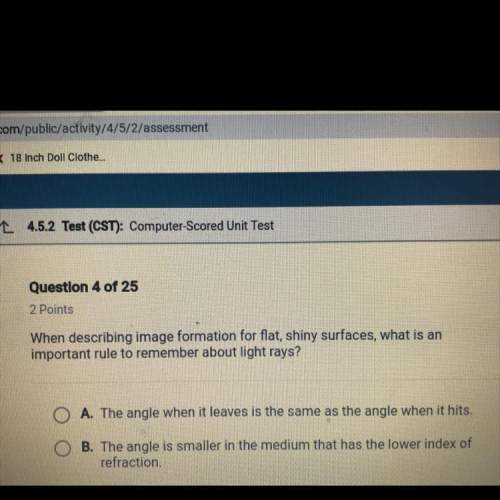
Physics, 31.07.2019 17:30 nathalyviruete
How do two negatively charged particles behave when held close together and then released? they accelerate away from each other. they accelerate toward each other. they move at a constant speed away from each other. they move at a constant speed toward each other.

Answers: 2
Another question on Physics

Physics, 22.06.2019 13:00
The magnitude of the amount of energy released by burning a fuel source, measured in energy per unit mass, is called its fuel value. note that the fuel value is the negative of the isobaric specific heat of combustion for the fuel. if all the energy obtained from burning 1.23 pounds of butane with a fuel value of 10.85 kcal/g is used to heat 128.0 kg of water at an initial temperature of 18.3 °c, what is the final temperature? note that 1 lb = 453.6 g.
Answers: 3

Physics, 22.06.2019 17:20
Which is not true of the intertropical convergence zone? a) it features heavy precipitation b) it's where the trade winds collidec) it's a high-pressure zone with sinking air d) it is also known as the doldrums
Answers: 2

Physics, 22.06.2019 18:20
Awave with a frequency of 500 hz is traveling at a speed of 100 m/s.what is the wavelength?
Answers: 1

Physics, 22.06.2019 19:30
Amass m = 74 kg slides on a frictionless track that has a drop, followed by a loop-the-loop with radius r = 18.4 m and finally a flat straight section at the same height as the center of the loop (18.4 m off the ground). since the mass would not make it around the loop if released from the height of the top of the loop (do you know why? ) it must be released above the top of the loop-the-loop height. (assume the mass never leaves the smooth track at any point on its path.) 1. what is the minimum speed the block must have at the top of the loop to make it around the loop-the-loop without leaving the track? 2. what height above the ground must the mass begin to make it around the loop-the-loop? 3. if the mass has just enough speed to make it around the loop without leaving the track, what will its speed be at the bottom of the loop? 4. if the mass has just enough speed to make it around the loop without leaving the track, what is its speed at the final flat level (18.4 m off the ground)? 5. now a spring with spring constant k = 15600 n/m is used on the final flat surface to stop the mass. how far does the spring compress?
Answers: 3
You know the right answer?
How do two negatively charged particles behave when held close together and then released? they acc...
Questions

Chemistry, 11.11.2019 11:31

Mathematics, 11.11.2019 11:31



Geography, 11.11.2019 11:31





Social Studies, 11.11.2019 11:31

Social Studies, 11.11.2019 11:31




Mathematics, 11.11.2019 11:31

Health, 11.11.2019 11:31




Geography, 11.11.2019 11:31




